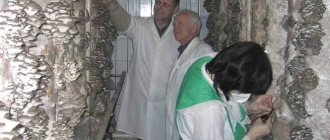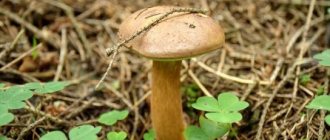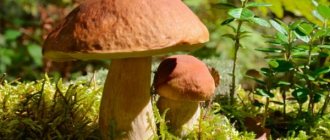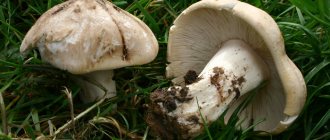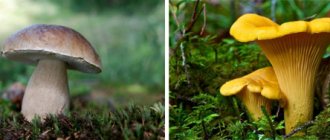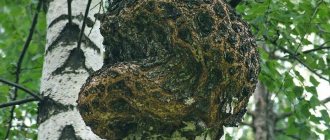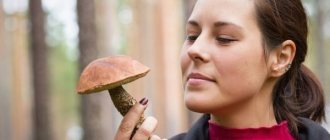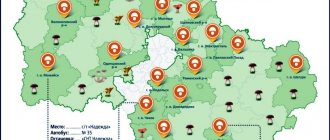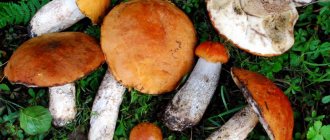At the end of every summer, the time comes to take a basket or even two and go picking mushrooms in the forest kingdom. Mushrooms, the species of which grow in central Russia, have a lot of useful nutritional qualities, and the use of some of them easily satisfies the human need for meat and animal products. Of course, we are talking about edible mushrooms.
In addition to beneficial nutritional properties and unique taste, mushrooms are also good because they give you the opportunity to fully relax during collection. There is little that can compare with a long walk through the morning forest, accompanied by frequent squats and bends towards the noticed owners of bright hats.
What types of mushrooms are there?
Mushrooms are divided into:
- edible;
- conditionally edible;
- poisonous.
Belonging to one or another category is determined by the properties of mushrooms. However, among the people, mushrooms are divided more simply into edible and poisonous, without going into such a concept as “convention”. Indeed, few people will take a mushroom that has been eaten by worms, is old and rotten, soggy or overgrown with mold, or is incomprehensible and unfamiliar in appearance. Therefore, ordinary people do not feel the need for information about conditionally edible states and types of mushrooms.
Mushroom guides
Each of us is faced with the fact that we do not know some mushrooms. Which is no wonder given such diversity. This leads to real inconvenience. So, my former classmate does not eat any mushrooms, except those that her father collects. She herself does not understand them and trusts only him. Therefore, the question of buying mushrooms in a store or from grandmothers does not even arise before her.
Perhaps experienced mushroom pickers are reluctant to share their places, but they will not refuse to advise newcomers. Once, after a successful “hunt,” I was waiting for a bus to Moscow with a whole box of young and strong boletus mushrooms. My joy knew no bounds, until a random fellow traveler dumbfounded me that I had collected a whole bunch of “false boletus mushrooms.” They are also called “Ball mushrooms”. They are not poisonous, but are inedible due to their bitter taste.
I was shocked - at first glance, the mushroom is completely impossible to distinguish from an ordinary boletus mushroom. It differs in color at the incision site. The false boletus will have a pink color, and the common boletus will have a white color. I had to shake all the mushrooms out of harm's way.
Nowadays, electronic mushroom picker guides, of which there are a great many, can help avoid such problems.
The most popular of them:
"Mushroom Picker's Guide"
The program describes 314 types of mushrooms, from edible and conditionally edible to inedible and poisonous. In addition to a detailed description, the application contains more than 1,400 photographs of mushrooms from various angles.
The application contains an amazing “Seasonality” section, where there is a detailed mushroom calendar by month. Subsection “For mushrooms!” allows you to see growing mushrooms at the moment.
The section “Articles about mushrooms” is a storehouse of useful information for beginning mushroom pickers.
As of August 31, 2016, the program had been downloaded by more than 100 thousand mushroom pickers.
Photo: m24.ru/Ivan Nosatov
“Mushrooms, Berries, Herbs. Directory-Navigator 3 in 1"
The program contains 320 units of mushrooms. The appearance is described in detail and color photographs are provided. Not only the growing area and ripening season are indicated, but also how the mushroom is eaten.
Mushrooms are divided into 6 categories: known edible, little-known edible, conditionally edible, with unknown properties, little-known inedible, poisonous inedible.
The program has a built-in GPS navigator based on the Google Maps service, which allows you to mark mushroom and berry places so that you can quickly return to them on your next trip to the forest.
The developers have provided the application with ten useful tips: “Tips for beginners”, “What to take to the forest?”, “Folk signs”, “Orientation in the forest”, “Collection technologies”, “Hallucinogenic mushrooms”, “Meeting animals”, “First aid” ", "Processing mushrooms", "Mushroom poisoning".
As of August 31, 2016, the program had been downloaded by more than 50 thousand mushroom pickers.
Android device users are luckier than iPhone owners. The selection of mushroom reference books is wider here. They are certainly useful, but do not forget that their manufacturers are not responsible for your health. Remember the rule? If you come across a dubious mushroom, pass by.
Which ones are edible?
The most common edible mushrooms in the forests of the middle zone are:
- boletus;
- boletus;
- boletus;
- white;
- milk mushrooms (white and black);
- volnushki (svinushki);
- flywheels;
- boletus;
- saffron milk caps;
- chanterelles;
- valui (calves);
- Russula.
In addition to them, in recent decades they have begun to actively collect champignons, both forest and field, which traditionally in Rus' were not brought home in baskets, just as white ones were not taken in Switzerland from time immemorial.
Of course, the types of edible mushrooms are not limited to this list. However, it is these forest creatures that most often end up in baskets.
Boletus and boletus
These types of fungi prefer deciduous or mixed forests with a predominance of birch and aspen trees. They are considered “relatives” of white mushrooms and, of course, the “king of all mushrooms” - boletus. These types of mushrooms differ from each other in the color of the cap and the pulp under it, as well as in taste. This is due to their symbiosis with different trees - aspen does not give dark smoky shades to the mushroom, as birch does.
Their hats are like this:
- from smoky grayish to rich chocolate, almost black - in boletus mushrooms;
- colors of autumn leaves, brown, red, terracotta, dirty red - in boletuses.
The nutritional properties of mushrooms are equivalent. From a culinary point of view, there are no differences between them either. They are fried, boiled, stewed. Soups and cabbage soup are prepared from them. They are dried for the winter and frozen. Young, strong, “pot-bellied” mushrooms can be pickled. In terms of taste, this dish is in no way inferior to a jar of salted boletus mushrooms. But these varieties of mushrooms do not like vinegar; pickled boletus and aspen boletuses are very bitter.
Deciduous forests can consist of either one species of deciduous trees -birch groves, aspen groves, oak groves - and from a mixture of species. Homogeneous deciduous forests are characterized by species of fungi that live in symbiosis with this tree species.
Birch forests are rich in various mushrooms.
Boletuses grow abundantly here, preferring bright places on the edges, clearings, along roads, on hills with sparse trees. Marsh boletus grows in mossy lowlands and sphagnum bogs overgrown with birch, along with marsh russula. In light and dry birch groves, white podgruzdok is often found, usually growing in groups forming wide arcs - parts of huge “witch circles”.
Here you can also find many varieties of russula - blue-yellow, greenish, edible, beautiful, brittle - as well as pink and white russula, umbrella mushrooms, various types of milk mushrooms, rows and talkers. In the summer, summer honey fungus grows in damp young birch forests and on birch stumps, and in the fall, true autumn honey fungus grows.
In light, sparse birch forests there is a birch variety
b porcini mushroom - a large, dense, beautiful mushroom with a brownish cap. Chaga grows on living birch, which has long been used in folk medicine against liver diseases and various inflammations of the stomach and intestines. In birch forests with fertile soil, valui grow abundantly. Along the outskirts of swamps overgrown with birch trees there are floats that can be distinguished from fly agarics by the absence of a ring on the stem.
From poisonous mushrooms in birch forests
The red fly agaric and the panther fly agaric are numerous, and the pale grebe is also common.
Grows in oak forests
oak mushroom, bruise, semi-white mushroom, chestnut mushroom, green and fissured fly mushrooms, some varieties of russula. The oak variety of porcini mushroom is found in clearings and edges of oak forests, usually in old park-type forests. Among the lamellar mushrooms you can find dark brown milky mushroom, oak milk mushroom, and pepper milk mushroom, which grow in large clusters even in very shaded places.
In mixed forests
Deciduous trees grow many species of mushrooms. In broad-leaved forests there are various types of oyster mushrooms, polypores and honey mushrooms, cherry blossoms, russula, porcini mushrooms, semi-white and chestnut mushrooms. Small-leaved forests abound in boletus, aspen, russula and various milk mushrooms, including milk mushrooms, yellow, black, blue, valui, violin and many other mushrooms.
However, mixed deciduous-coniferous forests
. Depending on the composition of tree and shrub species, you can find any mushrooms growing in symbiosis with them. For the composition of mushrooms, the main tree species, as well as the age, density and humidity of the forest, are primarily important. In damp forests with a predominance of birch and aspen, with an admixture of spruce, one can expect boletuses, boletuses, black milk mushrooms and oyster mushrooms, and here honey mushrooms and oyster mushrooms grow in clearings. In light, grassy, moderately moist birch-aspen forests with fertile soil, valui and russula grow well. In the dry pine-birch forests, on the small hills, white boletus, boletus, small milkweed, russula, greenfinches and silverbacks grow. In spring, in such forests, morels and morel caps appear in light, thinned places, especially in old fires. In damp, swampy pine-birch forests, in blueberry fields, and in sphagnum bogs, moss mushrooms, goat grass, bog boletus, boletus and russula, floats and moths grow.
To successfully collect mushrooms, you need to choose the right forest.
In the dry season, for example, it will be better to go for mushrooms in a damp forest, but in very wet seasons, on the contrary, it is better to prefer elevated places. Old, dense, gloomy forests are usually poor in mushrooms, both in composition and quantity, but in a young birch forest that has barely outgrown a bush, there may be a variety of different mushrooms. In forests with tall, dense grass, there are usually few mushrooms, so you need to choose places where there is little grass and the forest floor can be seen through it.
A novice mushroom picker should remember:
that most mushrooms prefer edges, clearings, sparse places warmed by the sun, and only a very few mushrooms, such as milk mushrooms or oaks, climb into thickets and on the slopes of ravines. An inexperienced mushroom picker can pick up a basket of a wide variety of mushrooms without going far into the forest, but you need to know them well in order to be in the right place at the right time and come out of the forest with a basket full of porcini mushrooms, saffron milk mushrooms or milk mushrooms.
In autumn, liverworts grow at the base of trunks or on the trunks of old oak trees.
a is a fleshy, oval-shaped mushroom that reaches several kilograms. On the roots of old oak trees grows a leafy tinder fungus or ram fungus, which from a distance looks like a lying sheep. When young, this mushroom is edible.
Typical of poisonous mushrooms for oak forests
brick-red false honey fungus, inhabiting oak stumps.
Pure aspen forests are usually poor
mushrooms, but they also have their own characteristic species, such as boletus and aspen mushroom. Here you can find blue-yellow russula, sometimes in large quantities, and plain-looking russula. Aspen stumps in cleared areas are a favorite place for oyster mushrooms, autumn and winter honey mushrooms to settle.
Many types of mushrooms grow in mixed hardwood forests
. In broad-leaved forests there are various types of oyster mushrooms, polypores and honey mushrooms, cherry blossoms, russula, porcini mushrooms, semi-white and chestnut mushrooms. Small-leaved forests abound in boletus, aspen, russula and various milk mushrooms, including milk mushrooms, yellow, black, blue, valui, violin and many other mushrooms.
Edible mushrooms growing in mixed forests, criteria for their differences, and favorite places of growth will be considered today.
general characteristics
The composition of representatives of the fungal kingdom, characteristic of a particular area, is determined by many criteria, among which the following factors are of decisive importance:
Humidity level; Solar radiation intensity; Soil composition; Vegetation composition; The influence of anthropogenic factors and so on.
Moreover, areas characterized by approximately the same conditions can differ significantly in the composition of representatives of the fungal kingdom. Consequently, the uniqueness of this world is determined by a combination of factors, the decisive of which are the degree of humidity and the predominance of certain plant species. I will briefly discuss the most common mushrooms growing in mixed forests.
Porcini
This is a very rare mushroom, but its taste characteristics, as well as the degree of nutritional value, force it to be put in first place. It is these representatives of the mushroom kingdom that are most valued by mushroom pickers in Russia and the countries of the former Soviet Union.
The porcini mushroom has a characteristic appearance: a large thick cap located on a massive stalk. Its color is quite variable and can be either light brown or violet-brown.
The flesh of the mushroom is very dense, it is quite difficult to press it with your fingers. The appearance of the mushroom is quite characteristic, and therefore, having seen it once, there are usually no difficulties in identifying it in the future.
The favorite place of growth is large, clean clearings, free from dead wood or decomposed remains of trees. Sometimes they can be found under oaks and large old birches and some other deciduous trees. Most often they grow at the height of summer - late July, early August.
Porcini mushrooms are great for any culinary creations. They can be pickled, fried, boiled, dried, baked. In general, it is quite difficult to spoil dishes made from them.
Boletus
Tubular edible mushroom. The appearance, as in the previous case, is very characteristic: a bright orange cap, medium massiveness and a thick stem. A qualitative feature is the presence of small, numerous dark scales on the stalk. It is the combination of a bright cap and a typical leg that makes it truly recognizable.
Despite its name, which eloquently hints at its favorite places of growth, it can be found not only under aspens, but also under oaks, birches, and many other deciduous plants. They usually grow in colonies, sometimes numbering dozens of representatives.
The best time to collect boletus is from the end of July to the beginning of October. It is not recommended to collect them after prolonged rains or in hot weather. When these two factors are combined, the pulp of the fungus will in most cases be eaten away by worms.
boletus
Its characteristic difference is the presence of a dark brown shiny cap with relatively smooth edges and a regularly rounded shape. The stem of the boletus is quite thin and colored in white and gray tones, with characteristic dark scales.
The boletus prefers moist soil. The best time to collect is late summer, early autumn. Most often they are found, naturally, under birch trees. However, they can also be found under other deciduous trees.
Russula
This species can be found even on dry soils and in not very wet years. They can be collected from about mid-summer until the first frost. The vernal appearance is quite variable: the shape of the cap can be flat or have edges curved downwards. Its color can be blue, red, pink, white greenish and so on. The leg is always light and thin.
The name russula does not accurately reflect the taste of the mushroom. Yes, it is not poisonous and can be eaten raw, but, nevertheless, its pulp is very bitter and if you eat a large amount of mushrooms raw, you cannot avoid digestive upset.
Gruzd
A lamellar mushroom that grows exclusively in coniferous forests and sandy, moist soils. The diameter of the cap can reach impressive sizes, up to half a meter. Its color can be light brown with a greenish tint.
Milk mushrooms grow mainly from August to the end of September. Most often they grow in colonies, but they can also occur one or two at a time.
Volnushka
The most common are pink flakes, although their color can vary from white to grayish. The diameter of the cap is up to 12 centimeters, and it has a characteristic appearance: a concave middle and edges. The flesh of the mushroom is strong and quite fragile. They crumble easily under mechanical stress and grow mainly in colonies.
Chanterelle
The cap and leg are painted in a bright red color, which, combined with a special funnel-shaped shape, makes them absolutely recognizable. Their main feature is that they are absolutely unattractive to worms, which means that even in warm and humid weather they will not be eaten away.
Chanterelles grow only in colonies, sometimes numbering up to a hundred pieces. They can be collected from mid-summer to the end of October. You can prepare a great variety of different culinary dishes from them.
Ryzhik
A distinctive feature of saffron milk cap is its bright orange color. The cap reaches up to 10 centimeters in diameter. When it is cut, a red sap appears that quickly darkens in the air. Favorite habitat is spruce forests. There are both single mushrooms and quite impressive colonies.
Honey fungus
In structure they are lamellar mushrooms. Color ranges from pale pink to slightly yellowish. The cap has a significant number of dark-colored scales. Attention: there is a possibility of confusing it with a false honey fungus, the cap of which is completely missing scales. They always grow in colonies numbering hundreds of pieces.
Conclusion
Mushrooms growing in forests are useful, but also dangerous for those who are new to them. Before picking mushrooms, you should study their features especially carefully, preferably with pictures. Nowadays, there is no difficulty in creating your own catalog on your smartphone. Your phone is always with you, which means it’s not difficult to check with it.
I’ll start, perhaps, with those that were known to me, which I collected in the Chaldai forests and in the floodplain forests of the Irtysh River.
Oil can.
The butterdish is found only in coniferous forests, it looks like a birch tree, the cap is a slightly brownish hemisphere, the same tubular hemephoric spore part, the cap is held on a dense, not very thin, white stem. But the cap of the mushroom is moist and oily; after touching it, brown stains remain on your hands, difficult to wash off with the smell of pine needles.
Butternuts turn out very tasty when fried, either with or without potatoes. Fried in sunflower oil with onions, they are well preserved in the refrigerator. Mushrooms are also pickled and salted. After cooking they turn black. Before cooking, remove the top oily layer of the cap.
Porcini.
The porcini mushroom is one of the most beloved and noble mushrooms, the highest category. It is called white because of the color of the pulp when cut, which remains white even after preparing the mushroom for consumption. Spruce, pine and birch are distinguished depending on the place of growth.
Externally, spruce differs from white, growing in birch groves, in the color of the cap, which can be brown or reddish. The mushroom grows on a long white stalk, starting with a thickening. The color of the spongy spore layer is white, but as the fungus grows it changes color, and older ones may be green. When cut, it has a pleasant mushroom smell, which is typical for all whites. Found from July to late August. For food, the mushroom is consumed in almost any form, except raw.
Borovaya has the same cap color, but grows in pine forests and has a short thick stem, the cap is sometimes wrinkled. Found from June to mid-November Berezovik, white has a light cap slightly yellowing, the stem of the mushroom is not thick and long, softer than other forms. Collected from June to the end of October. All porcini mushrooms are prepared the same way.
Boletus.
There are three forms: brown, white, red. Mixed forest mushrooms come across all these forms. Found in almost all forests, but prefers aspen trees. Young mushrooms are decorated with an unopened red cap on a long, dense white stem with a black mesh; over time, the cap opens and turns gray. The spore network is white or gray. A distinctive feature is the blue discoloration of the white cut area of the mushroom. Suitable for eating fried, salted, dried; dried mushrooms can be used to make soup. During cooking, it changes from white and blue to almost black.
Ryzhik.
Near the pines of the mixed forest there is a camelina with an orange cap on a yellowish-brown stem that is hollow inside. In a young mushroom, the cap is spherical and as it grows, the shape changes and becomes flat with a dimple in the center. If there is high humidity in the air, it becomes covered with mucus, and the cap becomes shaped like stripes in a circle. When cut, the exuding milk quickly turns green. The areas touched also become greenish in color. The smell of the mushroom is resinous with a fruity tint. The mushroom is good when salted, but it can also be eaten fried with sour cream after boiling it in a saline solution. There is another form of camelina, found in spruce forests, distinguished by a lighter yellowish color of the cap.
Chanterelle.
Most often, chanterelles are found in deciduous forests, but they are also found in mixed forests. They grow in groups of several. The cap is funnel-shaped, as if corrugated, with a lamellar spore homeophore descending almost to the ground. The color of the mushroom is yellow or light orange. Never wormy. The flesh of the mushroom is elastic and white with a pleasant smell. The mushroom does not crumble or wrinkle. Chanterelles are fried or soup is prepared with them.
Russula
Russula is the most common mushroom that grows in all forests, in any weather, both warm and cold; the color of the caps is most often red, but they can be bluish-green, purple, or bright yellow. Growing on a white stalk, the structure of the mushroom is fragile. The spore part is lamellar. The mushroom is consumed fried, stewed, or cooked in soup. Some russulas are salted.
Boletus
Boletus or Boletus is the internationally recognized “king” of mushrooms. Many peoples have legends dedicated to it, in which the boletus appears to be the progenitor of all other mushrooms, both edible and poisonous. There are legends in which two boletus brothers appear. One of them gave the forests edible mushrooms. And from the mycelium of the second one, poisonous ones multiplied.
Today it leads the rare species of mushrooms and it is almost impossible to find any of its species, with the exception of white ones.
Boletus mushrooms can be not only edible; for example, some representatives of this forest family are poisonous:
- Satanic;
- beautiful or beautiful;
- legal or lawyer, almost never grew up here, but was often encountered in France;
- le kele;
- stocky;
- purple;
- porosporous;
- red-legged, similar to beautiful, but differs in bright red or orange “limb”.
It is very easy to distinguish inedible boletus species; they most accurately correspond to their popular names. However, finding them in our time is no less difficult than edible varieties of boletus.
Externally, edible boletus mushrooms are similar to porcini mushrooms, but they are more substantial and solid. If these two mushrooms are placed side by side, the difference between them will be the same as between a peasant woman and a queen, a mongrel and a Molossian Great Dane.
As for culinary features, there are none. Boletus is suitable for preparing any dishes, can be prepared in all ways and has no equal in nutritional value.
Poisonous mushrooms
Red fly agaric is a psychoactive poisonous mushroom. It is difficult to confuse it with other species due to its bright red cap with white spots. Distributed everywhere.
Due to the muscarine it contains, it is dangerous for humans. Eating fly agaric causes dizziness, drooling, disorientation, vomiting, and loss of consciousness. In especially severe cases it can lead to death.
Fly agaric red
Sulphur-yellow false honey fungus is a poisonous mushroom that differs from edible honey mushroom species by the absence of a ring on the stem, a yellowish stem and pulp, and an unpleasant taste. It grows in large groups on the edges of forests and old stumps. When consumed, it causes vomiting, sweating, and loss of consciousness.
Sulphur-yellow false honey fungus
Thin mushroom is a mushroom that was previously classified as conditionally edible and was eaten after soaking. However, recent studies have confirmed that the toxins contained in the mushroom accumulate in the body and can cause diseases of the hematopoietic organs, kidney failure, and respiratory arrest.
It has a brownish color, a funnel-shaped cap, fleshy and dense. The leg is thick, beige-brown, like the plates. It grows in both deciduous and coniferous forests.
Thin pig
Pale toadstool is the most poisonous mushroom found in the Belgorod region. Record holder for the number of deaths after consumption. The poison that is part of the toadstool is not destroyed after heat treatment. Symptoms of poisoning appear after 3-4 hours. Intestinal colic, low blood pressure, vomiting, diarrhea, irregular pulse.
If the victim is not provided with urgent medical care, the poison will destroy the liver and kidneys and cause death within 7-10 days.
The pale grebe is a bit like a champignon, but its cap has a greenish tint, and at the base of the stem there is a sac-like volva. The stem and plates are light, the flesh is strong, and there is practically no smell. It grows mainly in deciduous forests, forming mycorrhizae with oak, beech, and birch.
Death cap
White
The deciduous forest mushrooms recognized as the first in terms of nutritional value after boletus mushrooms are porcini. You should look for them on hillocks, forest edges, and clearings. Whites prefer places that are not completely damp and do not like close proximity to trees; they are “on their own.” The minimum neighborhood radius in the mycelium, that is, the distance between its so-called “circles” is 1 meter.
This means that, having discovered a porcini mushroom, it makes sense to look around and walk around its place of growth at a distance of at least a meter. Thus, the chance of finding other whites increases significantly.
The hat of these beauties is colored brown in all shades, and the leg is plump, expanding towards the ground. The flesh under the cap is white, but only in young mushrooms. The older it is, the brighter the yellow-greenish shades appear in the color of the pulp. Botanists explain this feature by symbiosis with herbs.
You can cook whatever you want from white mushrooms, as well as from boletus mushrooms. These mushrooms are equally good with any cooking method. Of course, white ones can be dried, salted and pickled.
Edible mushrooms
Boletus is the most common mushroom and belongs to the Boletaceae family. Most often they form mycorrhiza with birch, which is how they got their name. Grows in deciduous forests. It is easily identified by its brown cap - it can be light or dark depending on the growing conditions. There are specimens with both very dark and almost white caps.
A spongy layer of gray-beige color. The leg can be thin or thick, with dark specks. Does not change color when cut. Inexperienced lovers may confuse it with the gall mushroom, but it has a bitter odor, while boletus has a faint and pleasant mushroom aroma.
In the Belgorod region there are several types of boletus: black, marsh, gray, common. Everything can be eaten.
boletus
Boletus is a mushroom of the Boletaceae family. Easily identified by its red-brown cap, which looks velvety and matte. The leg is usually thick, depending on the species it can be white (white-legged boletus) or with dark specks.
The spongy layer is dense and light in color. In young mushrooms, it fits tightly to the stem due to the spherical shape of the cap. Has a strong smell. It is difficult to confuse it with other mushrooms due to its recognizable appearance.
Expert opinion
Gennady Sergeevich Rylov
A great expert in mycology and an avid mushroom picker. Knows everything about mushrooms, their types and places of growth
A distinctive feature of boletus is that the cut leg acquires a bluish or greenish tint. It grows mainly in deciduous forests, but there are species that form mycorrhizae with pine trees (pine boletus).
Boletus
The porcini mushroom is the most valuable species growing in the Belgorod region. Easily identified by its thick stem, decorated with light mesh. The white ones that grow in coniferous forests are called “boletus mushrooms” - they have a brownish-brown cap; the larch white species are usually colored in light brown tones.
The spongy layer is dense and can be beige, white or pinkish. The aroma of the mushroom is very pleasant, quite strong. They grow in groups.
Porcini
The common chanterelle is an easily recognizable funnel-shaped mushroom of yellow-orange color. It does not have a clear boundary between the cap and the stem. The plates are quite large, with a pleasant fruity aroma.
Thanks to the substance quinomannose, which is part of chanterelles, they do not harbor worms. It usually grows in groups of 5-10 pieces. Prefers a temperate climate, forms mycorrhiza with oak, birch, spruce and pine.
Common chanterelle
Butterfly is an edible tubular mushroom. It is easily identified by the slimy skin of the cap, which gives it its name, and the ring on the stalk, a remnant of the spathe, which in young specimens may fit closely to the cap.
The tubular layer is yellowish or greenish in color, the leg is light. The color of the cap ranges from light brown to darker shades. They grow up in large “families”.
Common oiler
Autumn honey fungus is an edible agaric mushroom. It grows in large groups, usually on tree roots or old stumps. Color - from brown to yellowish. It has a ring around the leg - the remnant of the coverlet.
The cap can be convex in younger honey mushrooms and spread out in older ones. Often has scales. The leg is long, of medium thickness, light in color.
Autumn honey fungus
The real milk mushroom belongs to the genus of Milky mushrooms. It has a light color with a yellowish or pinkish tint. The aroma is strong and pleasant. It produces milky juice when cut. The cap is funnel-shaped, with characteristic pubescence along the edges, the plates are wide, light in color. The pulp is dense, slightly squeaky.
Before eating, real milk mushrooms must be soaked in a salty solution to remove the bitter taste.
Real milk mushroom
Russulas are a lamellar edible species. Usually the cap has a bright color: pink, yellow, purple, green. The shape can be spherical, flat or spread out. The plates and stem are most often white. The mushroom is fragile and breaks easily. The pulp is loose and may be spongy.
It does not change color when cut and does not have milky juice. Usually grows in small groups of 3-5 pieces.
Russula
Milk mushrooms, saffron milk caps and volushki
These types of mushrooms are united not only by the traditional method of their preparation - pickling and marinades, but also by related origin. And they prefer similar places in the forest - damp or close to water, the slopes of ravines, lowlands and other areas with high humidity.
Moreover, they grow up in neighborhoods and families. If a family of milk mushrooms or milk caps is discovered, then after collecting this “harvest” you should carefully search all the lowlands nearby; milk milk mushrooms will definitely be found.
They have the same structure - a hollow, dense leg and the same cap, but the colors are different:
- in milk mushrooms - white and black-brown;
- saffron milk caps are dirty orange, terracotta;
- the volnushki are pink, with fluffy fringe below.
These mushrooms can be used in different ways, but traditionally they are only pickled and salted. When fried, they become very bitter and become tasteless in soups, but they perform well lightly salted in salads.
Butterflies and moss mushrooms
These types of mushrooms are very similar in appearance. The difference between them lies in the lower, seamy plane of the cap and in the characteristics of growth. Butterflies grow in “families”, and moss mushrooms are proud “loners”. Moreover, unlike white mushrooms, having found a mushroom, you don’t have to try to look for others; the neighbor of the obtained mushroom can grow tens of meters away.
These types of mushrooms prefer coniferous forests. Butterflies love the conditions of pine forests, and moss mushrooms love to hide in spruce paws. Both mushrooms are colored brown, the differences between them are as follows:
- small, very slippery, as if covered with mucus or grease, with yellowish dense flesh at the break - boletus;
- large, with a large cap at the bottom similar to yellowish moss - moss mushrooms.
Both types are ideal for frying, preparing all types of hot dishes and marinating. You can also freeze them. But these mushrooms do not tolerate drying well.
Chanterelles
They got their name because they look like fox faces, although it is not clear what exactly they are. Their cap smoothly flows out of the stem; sometimes it may seem that there is no stem at all, and the mushroom consists only of a shaped cap.
The color of the mushrooms ranges from pale yellow to fiery red, depending on the composition of the soil in which they grew. Mushrooms grow not just in families, but in large colonies. This explains their overwhelming abundance on market stalls. You can literally pick a large basket of chanterelles without leaving one place.
These mushrooms are used for frying, salting and pickling. With all other cooking methods they lose their taste. However, chanterelles dry well and are quite suitable as a filler when preparing winter cabbage soup or other dishes.
Valui
They are not so common, but they are not rare either. These mushrooms look like a large and serious russula. As mushroom pickers joke, if you cross white and russula, you get valui. This joke is the most accurate description of the appearance of these mushrooms.
They are used as universal fillers in the preparation of any dishes, but they exhibit taste qualities only in pickles. Not suitable for winter preparations such as drying or freezing.
They prefer to grow on the edges of deciduous forests, with a predominance of birch trees. They do not like damp lowlands and an abundance of grass.
What mushrooms can be collected and at what time of year?
It is worth noting that the growth of mushrooms is tied not only to the time of year, but also to weather conditions - they love wet, warm weather, so the period of their appearance may vary. Boletaceae - boletus, boletus and boletus - usually grow between May and the end of October. They grow in “waves”, of which there are usually 2-4 per season, but in the interval between them there are also individual specimens.
Butterflies delight mushroom pickers at the beginning of the season, from mid-May to late July. Honey mushrooms appear closer to autumn - from approximately the first third of July to the beginning of November. Chanterelles emerge from June to August. Milk mushrooms are autumn mushrooms, appearing from late July to early October. Russulas grow throughout the season, from early May to October.
Coat of arms and flag of the Belgorod region
Russula
The most common mushroom. As those who like to wander through the forests with a basket joke: “No matter how many types of mushrooms exist, you will still collect russula.” Although they are more common than others, they are difficult to collect. Russulas are distinguished by their pronounced fragility and brittleness; they can turn into dust even in a basket.
Their nutritional and taste value is the lowest. The most optimal use of russula is as a filler in pickles and assorted marinades.
Externally, this mushroom is elegant. The leg is smooth, white. A hat of any color and shade, bright and attractive. There is no pulp underneath - the mushroom is a lamellar mushroom.
Which ones are poisonous?
The types of poisonous mushrooms are no less diverse than edible ones. It is simply impossible to remember all of them, and it is not necessary. When collecting forest harvests in a basket, you should be guided by the golden rule - “if you’re not sure, don’t take it.”
More often than others in Russian forests you can find:
- fly agarics;
- pale toadstools;
- false honey mushrooms and chanterelles.
The “king of all toadstools,” that is, the false boletus, better known as the satanic mushroom, is now difficult to find, as is its edible relative. Also rarely found are false whites, aspen boletus or boletus. It is not difficult to distinguish them - all poisonous counterparts of purebred mushrooms have a strong unpleasant odor, noticeable when their caps are broken, pulp of “inedible”, acidic shades and “skinny” crooked legs. Even a person who finds himself in the forest for the first time and has seen mushrooms only in pictures will confidently say when he sees false doubles that there is something wrong with these “gifts of nature.”
When, where, what and how to collect
The mushroom season depends on what kind of mushrooms to collect, said Alexander Kurakov, head of the department of mycology and algology at Moscow State University, Doctor of Biological Sciences.
“The most delicious time for mushrooms is the second half of August, September. At the same time, there are those that grow until November. Oyster mushrooms grow until frost, when snow already falls,” Kurakov noted. - Now is a good time to go to the forest. A few insects and worms. If good weather continues with periodic rains and without prolonged frosts, then mushroom pickers will be able to harvest for a long time.”
According to the forecast of the Hydrometeorological Center of Russia, from September 3 to September 8, the Moscow region will experience light rain. It will get colder, but only slightly.
The Moscow region forests and green areas of the TiNAO are perfect for picking mushrooms. It is believed that the most environmentally friendly mushrooms grow in the west of the Moscow region. There are few polluting industries here, and westerly winds keep the air clean.
There are “mushroom stations” on almost every railway line. For example, mushroom pickers leaving the Belorussky station can stop at the Zhavoronki, Zvenigorod, Skorotovo, Petelino, Tuchkovo, and Dorokhovo stations. This area is distinguished by the predominance of porcini and boletus mushrooms.
"Morning": Mushroom places in the Moscow region
Porcini mushrooms, aspen mushrooms, and boletus mushrooms grow mainly in mixed forests, that is, in coniferous forests mixed with oak forests and birch forests. In the pine and spruce forests you can get a good harvest of boletus, milk mushrooms and saffron milk caps. Oyster mushroom grows on tree trunks and dead wood.
Mixed forests (coniferous and deciduous) are the most diverse in the composition of mushrooms. The mixed forest has a diverse plant community, which is why a wide variety of mushrooms grow in it. Preference should be given to mature forests of venerable age.
My friends and I started going to the Ikshinsky forest in the Dmitrovsky district about 10 years ago. A group of about five people boarded a train in Moscow, identified the “real” mushroom picker and began to follow him. He got off the train and we followed him. He's on the bus - we're not far behind. The road divided the forest in half, he went in one direction, we went in the other - we haven’t changed the place since then. There is a potato field nearby - a win-win option. One day we didn’t get any mushrooms, so I returned with a full box of new potatoes. Evgeny Polunin
Mushroom and potato hunter
In total, the Russian flora includes approximately 200 species of cap mushrooms. Of these, only about 40 are edible, and the vast majority of edible mushrooms must be pre-treated in a special way, since they contain poisonous or bitter substances.
Among poisonous mushrooms, toadstool is considered one of the most common and dangerous mushrooms. However, even edible mushrooms can be dangerous if you collect them along roads, near industrial facilities or in the city. This is due to the fact that mushrooms accumulate heavy metals from the soil, so they must be collected in environmentally friendly places. Don’t be too lazy to move away from the road at least half a kilometer deep into the forest.
The most necessary things are always somewhere nearby. For 10 years now, my grandmother has been collecting most of the porcini mushrooms right outside the fence of her summer cottage in the Podolsk region, while crowds of mushroom pickers pass by these places. Even after all the dacha neighbors come out of the forest with full baskets, the grandmother goes to collect them in secret places that are right in plain sight. For example, right next to a country road leading to another village there seems to be a passageway, but no one ever looks there. Thus, today she did not have to go anywhere at all; the basket was filled a couple of meters from the house at the top of the ravine behind the fence. Olga Garina
Mushroom picker's granddaughter
Mushrooms are not only edible and poisonous, but also inedible. This means that the mushroom is not dangerous to health, but should not be eaten - usually due to its terrible taste, which cannot be changed by any pre-treatment. What’s even more interesting is that there are no less inedible mushrooms than poisonous and edible ones.
In everyday life, it is customary to divide edible mushrooms into noble and ignoble. The gradation, although not scientific, is not without meaning. High quality mushrooms have better nutritional value and taste. Boletus mushrooms, white mushrooms, chanterelles, saffron milk caps, and milk mushrooms contain more protein, vitamins, and polyunsaturated fats. At the same time, the so-called base russula and fly mushrooms are absolutely edible.
Chanterelles differ from most mushrooms in that they are never wormy. In addition, they are almost completely indifferent to sunlight and are generally quite unpretentious. They grow during rainstorms, in hot and cool weather. Therefore, when there are no other mushrooms, you can rely on chanterelles.
Unfortunately, there is no universal rule for distinguishing an edible mushroom from a poisonous one. Due to the wide variety, everything is very individual. Therefore, the main advice to any mushroom picker, if in doubt, pass by.
Beginning mushroom pickers are like fishermen. They begin to brag about the harvest - “Wow, I found such a white one yesterday” - and slap themselves on the elbow with the edge of their palm. This is mistake. It is better to collect smaller, but younger mushrooms - they are of higher quality than large mushrooms, which are already beginning to decompose.
As Kurakov recommends, it is better to carefully turn the mushrooms inside out and then remove excess soil from the stem. And then you will have a clean copy in your basket. In this case, you will not damage the mycelium. And if you cut the mushroom, the lower part of the stem will begin to rot. Insects, infections and bacteria will penetrate there.
In Russian forests, nature annually “grows” about five million tons of mushrooms. However, mushroom pickers collect only about 10 percent of this amount. Often, mushrooms grow in deserted areas, in extremely inaccessible places, and getting to them is not at all easy.
Fly agarics
Fly agarics are familiar to everyone, even those who have never been in the forest. In addition to the traditional “our native” fly agaric with a red hat and white spots, there are orange, green, and even blue varieties. If you find a family of fly agarics in the forest, you don’t need to break them. Although they are useless for modern humans, fly agarics are needed by the forest and its inhabitants, and not only by squirrels or hedgehogs, but also by trees. This fungus, for example, is a natural enemy of aphids, mold and other parasites that destroy entire forests. In the old days, medicines were prepared from fly agarics. Therefore, the mushroom should not be spoiled. In addition, the types of mushroom reproduction are quite complex, and by kicking a young fly agaric, you can make it so that it will never grow in that place again.
What to do if you get lost
More than 75 lost mushroom pickers have been rescued since the beginning of the week
The forests near Moscow are huge, and every year rescue teams are sent to search for missing mushroom pickers. Since the beginning of the year, the forest guard has already received applications from more than 250 lost people. The onset of the mushroom season led to the fact that at the end of August, 76 lost people were brought out of the forests of the Moscow region in just 4 days. According to statistics, in the region most often people get lost in the Klin and Volokolamsk forest districts.
The head of the TiNAO department of the Russian Ministry of Emergency Situations in Moscow, Sergei Musayelyan, told how they recently managed to save an elderly woman who got lost in the forest. 74-year-old Tamara Nikolaevna from the village of Chirikovo in the Trinity Okrug went into the forest to pick mushrooms on August 30. Only a day later, at 18:40, her son Konstantin came to the Krasnopakhorskoe police station with a statement of disappearance. The woman's phone number was unreachable.
The woman was found only on September 1 at 13:20 - just about one and a half kilometers from her home village. The rescuers were seriously worried about her life, given her age and weather conditions. A storm warning was issued in those days. The woman spent two days in the forest in the rain, thunderstorm, squally wind, and perhaps even hail. She felt very bad - she was hospitalized at Trinity City Hospital. The rescuer is convinced that such a test affected not only the physical health of the rescued woman, but also her psychological state.
In search work, rescuers mainly rely on their feet and quadcopters with a video camera (a type of unmanned aerial vehicle - note m24.ru). In the case of Tamara Nikolaevna, they organized a working group under the leadership of Musayelyan and set out to search. In addition to the rescuers themselves (canine handlers with dogs, motorcyclists), the “Lisa Alert” public search team of 20 people took part in the search. Traditionally, the student body - five people - provided assistance. Employees of the Department of Internal Affairs of the Krasnopakhorskoye settlement helped. And even five people from the settlement administration. The Russian Union of Rescuers and the Nadezhda organization also participated in the search.
“I think it is a human duty to help one’s neighbor if he is in trouble,” says Musayelyan. “It was nice to see the help of local residents who also took part in the search for Tamara Nikolaevna. This is a great help - the person who provides such help does it from the heart.”
I recently visited friends in Sergiev Posad. There, outside the territory of the former Smena pioneer camp, there is a large forest in which various mushrooms grow. We were walking there and didn’t plan to collect anything, but then we noticed a little boy carrying a ferret or some other small beautiful brown animal in his hands. We thought that he would mock him and ran to save the supposed ferret. It turned out that the boy found an amazingly beautiful mushroom and went to his home to get a bag to collect more. He told us that they come there every weekend with their parents and collect a whole bunch of mushrooms, which they then dry and add to soup in the winter. These are a variety of types of mushrooms. But there is also a strange one: they say that if you step on it, it will spray something gray on you. Can ruin your shoes forever. We asked the boy to show us this mushroom, we stepped on it, but nothing happened because it was not yet mature. Lastochkina Anastasia
Lover of walks in the forest
“Dusting Mushroom” Photo: m24.ru/Anastasia Lastochkina
Remember a few small and simple rules that will save you from major troubles.
- Warn your family and friends that you are going to pick mushrooms and tell them what time you plan to return. Indicate the forest in which you are going to pick mushrooms, or better yet the entire route;
- Dress brightly. Leave your camouflage at home, you are not going to war. They may not find you in khaki clothes, even if you are very close. It is best to wear tan, red, yellow or white jackets. It wouldn’t hurt to stick on reflective strips or patterns;
- Bring a whistle with you. The noise it makes will help find you faster. Don't forget matches, a knife, a small supply of water and food. If you are constantly taking medications, do not forget about them;
- Be sure to charge your mobile phone. It wouldn't hurt to bring an external battery. Store them in a bag so they don't get wet in the forest;
- Install navigators like Yandex.maps or Google.maps on modern smartphones and tablets. In these applications, forests near Moscow are detailed in detail.
If you still manage to get lost, don’t panic.
As the rescuer admitted, in his practice there have never been any deaths from lost mushroom pickers. They spent the longest time looking for the lost grandfather - 4 days - and found him. “We are looking until the end - until victory,” Musayelyan said. You can call rescuers from your mobile phone using the general “emergency” number 01 or 112 – even with a negative balance, and without a SIM card at all. If you get lost in a forest near Moscow, call directly the Crisis Management Center of the Moscow Region by phone: 8. The best phone reception is in an open area - a forest edge or a large clearing.
If you know that they will be looking for you, stay where you are and light a fire. Smoke will help detect you faster. If the phone is still dead, hearing sounds (a dog barking, a passing train) will help you reach people. If you have the strength, climb a tall tree and look around. Perhaps you will see nearby villages. It’s good if you managed to get to a power line, a railway, a gas pipeline, a river - when walking along these objects, you will always come out to people.
You should not move at night - this can lead to injury. So it's worth spending the night. Choose a place to spend the night that is high and dry, preferably near a large tree. Prepare brushwood for the fire and make bedding from spruce branches. Position yourself with your back to a tree, try to light a fire and keep it going all night.
False chanterelles and honey mushrooms
Honey mushrooms (edible), although they are very tasty and healthy mushrooms, are categorically not recommended for collection for those who do not have knowledge and experience. Since it is often beyond the power of even a hereditary mushroom picker with considerable experience, who has been going into the forest with a basket since early childhood, to distinguish true honey mushrooms from false ones. External differences between them are practically unnoticeable.
Although chanterelles (false) are incredibly similar to edible ones, even an inexperienced person can tell them apart with a careful look. False ones are covered with whitish growths on the inside. It feels like the fungus has teenage acne. The coloring itself is bright, but not healthy, it’s like a fox that looks like it’s “eaten with blood.” This mushroom also has dense flesh with bloody or pinkish-terracotta veins, which is immediately visible when broken, which is not present in normal edible species.
In general, when going to the forest, you don’t need to grab and put everything that comes along the paths into a basket. You need to take only those mushrooms that you are confident in. And it’s even better to go mushroom picking with a knowledgeable, experienced person.
